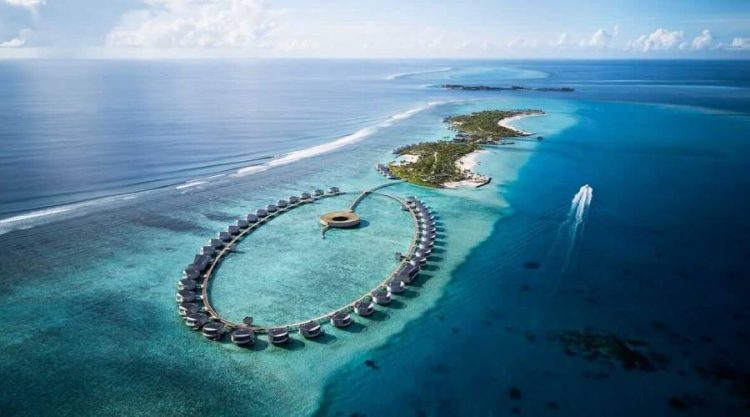“Maldives: A Tropical Paradise in the Heart of the Indian Ocean”

Nestled in the cerulean waters of the Indian Ocean, the Maldives stands as an enchanting archipelago, renowned globally for its pristine white-sand beaches, vibrant coral reefs, and luxurious overwater bungalows. The Maldives is a tropical haven that beckons travelers with its breathtaking landscapes and rich marine biodiversity. This article delves into the geographical location of the Maldives, exploring the coordinates that define this idyllic paradise.
Geographical Coordinates:
The Maldives is situated approximately between latitudes 7° 6′ 30″ N and 0° 42′ 30″ S and longitudes 72° 32′ 30″ E and 73° 45′ 54″ E. This places the archipelago southwest of Sri Lanka and India, making it a prominent feature in the vastness of the Indian Ocean. Comprising 26 atolls, each consisting of numerous coral islands, the Maldives spans a total area of around 298 square kilometers, making it the smallest Asian country in both land area and population.
Island Formation:
The Maldives’ unique geographical formation can be attributed to the underwater volcanic activity that occurred millions of years ago. As the Earth’s crust shifted and plates collided, underwater volcanoes erupted, giving rise to coral reefs that eventually formed the atolls we see today. These atolls are ring-shaped coral reefs surrounding a lagoon, and they create a distinctive and mesmerizing topography that defines the Maldives.
The Maldivian Archipelago:
The Maldives is made up of 26 atolls, which are further divided into over 1,000 coral islands. These atolls are spread across the equator, providing the Maldives with a tropical climate characterized by warm temperatures and consistent sea breezes. The archipelago is grouped into 20 administrative divisions, with each atoll having its unique charm and allure.
Capital and Major Atolls:
The capital city of the Maldives is Malé, located in the Kaafu Atoll. Malé is not only the political and economic hub of the country but also serves as a gateway for tourists arriving at Velana International Airport. Apart from Kaafu Atoll, other major atolls include Ari, Baa, Lhaviyani, and Alif Alif, each boasting its own distinct beauty and attractions.
The Coral Reefs:
One of the most remarkable features of the Maldives is its intricate coral reefs. These reefs, teeming with diverse marine life, contribute to the archipelago’s global reputation as a premier snorkeling and scuba diving destination. The Maldives houses some of the world’s most vibrant and intact coral ecosystems, making it a UNESCO World Biosphere Reserve. The health of these reefs is crucial not only for the Maldives but for the entire planet, as they support a delicate balance of marine life and contribute to the global ecosystem.
Climate and Weather:
The Maldives experiences a tropical monsoon climate, characterized by two distinct seasons – the northeast monsoon (dry season) and the southwest monsoon (wet season). The dry season, from December to March, brings clear skies, calm seas, and ideal conditions for water activities. Conversely, the wet season, from May to October, sees occasional rain showers and stronger winds. Despite the wet season, the Maldives remains a year-round destination due to its warm temperatures and welcoming atmosphere.
Rising Sea Levels and Climate Change:
While the Maldives’ location makes it a paradise for travelers, it also places the nation at the forefront of climate change challenges. The low-lying islands are particularly vulnerable to rising sea levels, making climate change a pressing concern for the Maldivian government. Efforts are underway to address this issue, with the Maldives actively participating in international climate conferences and adopting sustainable practices to mitigate the impact of climate change on the archipelago.
Tourism and Economy:
The Maldives’ economy heavily relies on tourism, and its geographical location is a key factor in attracting visitors. The archipelago’s remote setting, surrounded by the vastness of the Indian Ocean, offers a sense of exclusivity and tranquility that appeals to travelers seeking a luxurious and secluded escape. The Maldives has capitalized on its natural beauty, providing visitors with overwater bungalows, underwater restaurants, and a myriad of water-based activities.
Conclusion:
In conclusion, the Maldives’ geographical location in the heart of the Indian Ocean defines its character as a tropical paradise. The archipelago’s formation, coral reefs, and atolls contribute to its unique and captivating landscape. As a nation facing the challenges of climate change, the Maldives strives to preserve its natural wonders while providing an unforgettable experience for travelers. Whether it’s the pristine beaches, vibrant marine life, or luxurious accommodations, the Maldives continues to be a beacon of beauty and serenity in the vast expanse of the Indian Ocean.
Where is the Maldives located?
- The Maldives is located in the Indian Ocean, southwest of Sri Lanka and India. It is a tropical archipelago composed of 26 atolls, which are further divided into over 1,000 coral islands.
2. What are the geographical coordinates of the Maldives?
- The Maldives is situated approximately between latitudes 7° 6′ 30″ N and 0° 42′ 30″ S and longitudes 72° 32′ 30″ E and 73° 45′ 54″ E.
3. How far is the Maldives from India?
- The Maldives is located about 700 kilometers (430 miles) southwest of the southern tip of India.
4. What is the capital of the Maldives?
- The capital city of the Maldives is Malé, which is located in the Kaafu Atoll.
5. How many atolls make up the Maldives?
- The Maldives comprises 26 atolls, each formed by coral reefs surrounding a lagoon.
6. What is the climate in the Maldives?
- The Maldives experiences a tropical monsoon climate with two distinct seasons: the dry northeast monsoon (December to March) and the wet southwest monsoon (May to October).
7. What is the significance of the coral reefs in the Maldives?
- The coral reefs in the Maldives are vital for marine biodiversity and are recognized as a UNESCO World Biosphere Reserve. They contribute to the global ecosystem and make the Maldives a premier destination for snorkeling and scuba diving.
8. How vulnerable is the Maldives to rising sea levels?
- The Maldives is highly vulnerable to rising sea levels due to its low-lying islands. The government is actively engaged in climate change mitigation efforts to address this concern.
9. Why is tourism important for the Maldivian economy?
- Tourism is a crucial economic driver for the Maldives. The nation’s remote location, surrounded by the Indian Ocean, offers a unique and exclusive experience, attracting visitors seeking luxury and seclusion.
10. How can travelers reach the Maldives?
- Travelers can reach the Maldives by air, with Velana International Airport in Malé being the main gateway. Many international airlines operate flights to the Maldives, making it accessible to tourists from around the world.
11. Are there any specific travel restrictions or entry requirements for the Maldives?
- Travel requirements may vary, and it’s advisable to check with relevant authorities or the Maldivian tourism board for the latest information on visa requirements, COVID-19 protocols, and other travel-related guidelines.
12. What makes the Maldives a popular tourist destination?
- The Maldives is renowned for its pristine white-sand beaches, turquoise waters, vibrant coral reefs, and luxurious overwater bungalows. Its geographical location and natural beauty make it a sought-after destination for a romantic getaway, honeymoon, or tropical escape.






